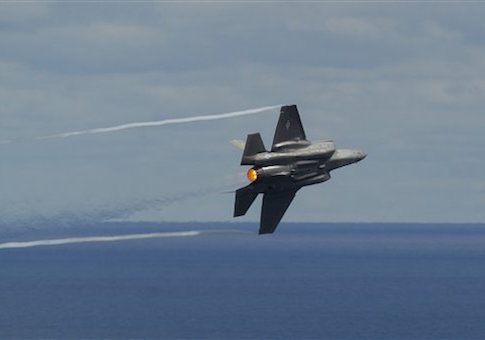The U.S. Air Force plans to deploy its F-35A Joint Strike Fighter jets to battle the Islamic State in the Middle East within the next few years to give the American-led coalition a new edge over the terrorist group.
Gen. Herbert "Hawk" Carlisle, outgoing commander of Air Combat Command, told reporters Friday that the deployment could arrive in the "not too distant future," following a small dispatch of the fighter jets to Europe and the Asia-Pacific region that could begin as soon as this spring, Defense News reported.
Carlisle predicted that the jet's enhanced sensor fusion capabilities and its situational awareness would help U.S.-led air forces better coordinate air strikes in Iraq and Syria, lower the risk of mid-air collisions with Russian aircraft operating in similar areas, and minimize surface-to-air threats.
"If you look at portions of Syria, it's a pretty dense surface-to-air threat inside that arena," he said, noting that both the Russian and Syrian militaries deploy air defense systems in the country to protect their facilities and assets.
"We try to deconflict. We try to make sure that they know that they need to not, certainly, illuminate our aircraft, but those systems are operating in that environment," he continued. "They’re not illuminating our aircraft with any type of target tracking radars or anything like that in large numbers or to any great extent that I know of. … But their radars are active."
Carlisle said the deployment of the F-35As is not yet imminent, but could occur a few years down the road.
The Air Force announced in August that the strike fighter had reach its initial operational capability, meaning the plane had met the minimum combat-ready requirements. The aircraft is still in the development phase with full combat capability expected in 2018, when the plane's critical Block 3F software package is due to be ready.
The United States will first deploy small detachments of F-35A jets to Europe and the Asia-Pacific region as early as this spring to determine whether the new aircraft is ready for a combat deployment.
Despite ongoing testing, the top Air Force officer warned against viewing the F-35 as a "PowerPoint plane."
Air Force Chief of Staff Gen. David Goldfein said Thursday at an event in Washington, D.C., that the plane performed "brilliantly" in recent Red Flag exercises and the Marine Corps successfully had a combat deployment of the plane.
"This is not a PowerPoint air plane, this is an aircraft that's flying and is ready for combat," Goldfein said. "My job is to ensure that we bring on that capability, because it's not only what the nation needs, because it's the quarterback of our family of systems, it's also what my joint partners need and it's also what my fellow global air chiefs need."
The Air Force already has F-22 Raptors fighting against ISIS in Iraq and Syria. Carlisle said the combination fifth generation detection capabilities of the F-35 and F-22 would enhance the Air Force's use of older, fourth generation jets like the F-15 and F/A-18 given that the planes are designed to operate together in the same network.
"I need them. I need the rotation," Carlisle said. "As soon as those guys are ready to go, we need them."
